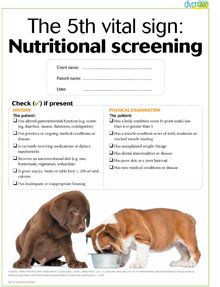Nutrition leaving a bad taste in YOUR mouth?
Temperature, pulse, respiration, pain assessment and nutritional assessment. Face it, assessing nutrition and serving up solid recommendations is vital to keep your veterinary patients healthyand your "foodie" clients happy.

Getty images“I want to feed my dogs a homemade gluten-free paleo diet with no GMOs. How do I do that?” Ah, nutrition … the topic that sometimes leaves a bad taste in your mouth. But you've gotta have this talk with clients. Pet owners are starving for nutrition information, and if they don't get it from you, the expert, they're going to get it from somewhere. And that source just might be the Twitter handle @PaleOMGpet who bases all her nutritional knowledge on her “extensive” study of wolves on Discovery channel docu-tainment or the French bulldog blogger who pushes a raw-food pet diet because she claims it provides enzymes essential to the pooch's healthy digestion. Scary.
You are the expert. When you talk nutrition, it's time to beef up your confidence to match your competence. Try these quick tidbits from Julie Churchill, DVM, PhD, DACVN, to make a big impact on disease prevention for your patients.
How to dish on nutrition
One respectable resource Dr. Churchill recommends to simplify this process: the 2011 World Small Animal Veterinary Association (WSAVA) Nutritional Assessment Guidelines. It promotes a global initiative to include nutritional assessments as the fifth vital sign (temperature, pulse, respiration, pain assessment and nutritional assessment) as a standard protocol when performing physical examinations and histories for all small animals.

Check out the WSAVA nutritional screening form to identify nutritional risk. (This is an extract from the WSAVA's Global Nutrition Toolkit, which is available for free download here.) In general, the more of these risk factors a patient has, the more you need to explore the current nutritional status of that animal and the more details you will need.
Tools: an entrée into foodie talks
Don't let Dr. Google tip the scales on what your patients eat! Take a few minutes at every visit to focus on every patient's nutrition. Use the tools from reputable sources, including the American Animal Hospital Association 2010 Nutritional Assessment Guidelines for Dogs and Cats, available here.
Remember, there's a person on the other end of the leash selecting and preparing that patient's food. Something Dr. Churchill asks her clients is, “What are your goals?” And then she explains to them, “Your pet is my priority, but you're my partner in helping your pet stay as healthy and happy as he can be for as long as he can be.” So let's practice this recipe for success and dig in!
Episode 67: Choosing trusted supplements
October 20th 2021In this episode of The Vet Blast Podcast, Dr Adam Christman chats with Dr Janice Huntingford about the latest insights into selecting the best supplements for your patients, including the importance of recommending and utilizing products that have a substantial amount of science and research behind them. (Sponsored by Vetoquinol)
Listen